Category: General

2025 Kia EV9 recalled for loss of drive power
The 2025 Kia EV9 is being recalled again because faulty rear gear drive units could cause loss of propulsion.
The recall includes just 342 of the three-row electric SUVs. These vehicles may have rear gear drive units containing motor shafts that were improperly welded during assembly by a supplier, according to the NHTSA. The shaft can become damaged as a result, impacting its ability to transfer power from the motor to the wheels, resulting in reduced acceleration and drive power.
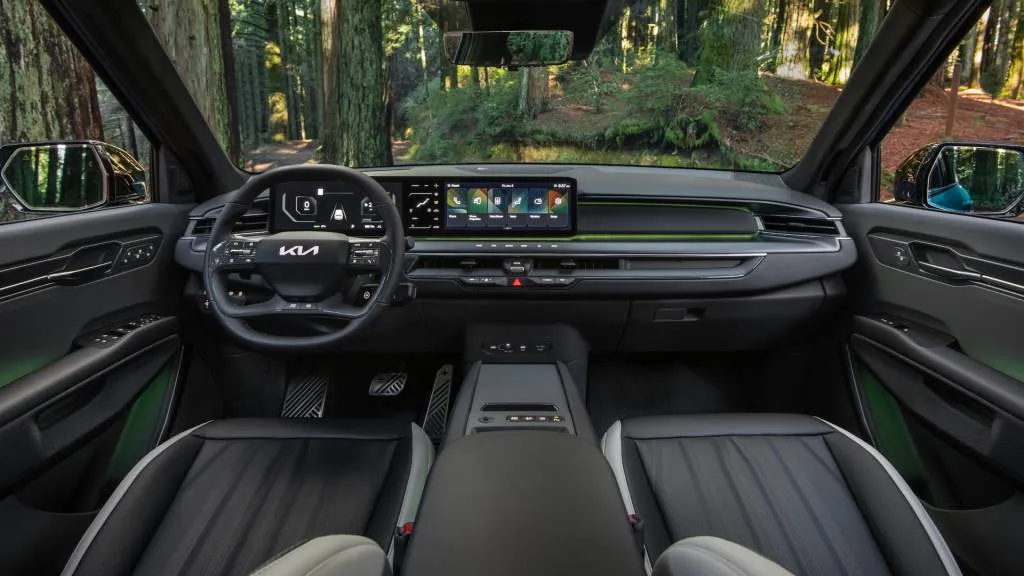
2025 Kia EV9
If this occurs, drivers may notice abnormal driveline noise and a “Check AWD/4WD” warning message on the dashboard, recall documents said.
Kia estimates that just 4% of the recalled vehicles (yes, that’s about 14 EV9s in all) actually have this defect, which also hasn’t been found in front drive units. And while single-motor versions of the EV9 are rear-wheel drive, the recall only covers dual-motor all-wheel drive models. Vehicles in the recall population were among the small number of Georgia-made EV9s in 2024.
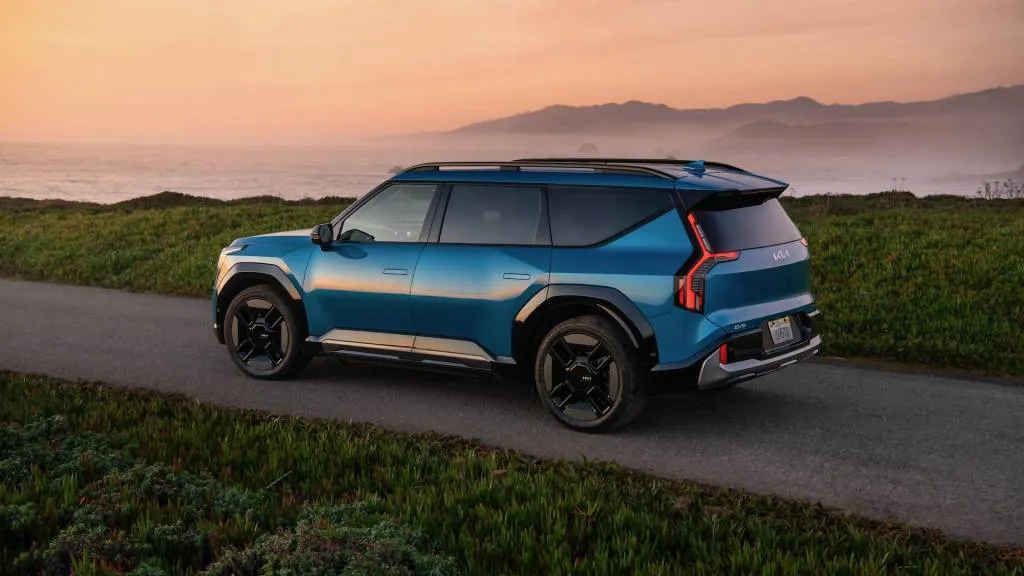
2025 Kia EV9
The remedy is replacement of the rear gear drive unit, which dealers will perform free of charge. Kia plans to mail owner notification letters starting Mar. 7. Owners can also call Kia’s customer service department at 800-333-4542 for more information or visit the automaker’s recall website. Kia’s reference number for this recall is SC337.
The EV9 launched for the 2024 model year to critical acclaim. Kia didn’t make many changes for 2025, and it doesn’t seem to have corrected all of the EV9’s teething problems, either. The 2025 EV9, along with some 2024 models, was previously recalled for missing seat bolts, and for failing digital instrument clusters.

Chevrolet Silverado EV ZR2 concept takes EV trucks off-road racing
- Chevy is taking the Silverado EV off-road racing in concept form
- The concept gets the ZR2 nameplate along with the Hummer EV’s powertrain, trick shocks, big tires, and skid plates
- A production variant is feasible and quite likely in the future
General Motors is looking to drum up interest in an upcoming off-road variant of the Chevrolet Silverado EV with a race-truck concept.
Unveiled Wednesday, the Chevrolet Silverado EV ZR2 will compete in the Mint 400 off-road race in Nevada, in the Open Production EV class. This class is for modified production vehicles, and while GM claims in a press release that the Silverado EV ZR2 uses 98% production parts, it’s not quite like what customers can buy right now.
Chevy uses the ZR2 designation for the more capable off-road versions of the internal-combustion Silverado and Colorado pickups, and in keeping with that the concept race truck features lifted suspension with dampers from Canadian firm Multimatic (which supplies dampers for the production ZR2 trucks), locking differentials, skid plates, and 37-inch BF Goodrich KM3 Mud Terrain tires.
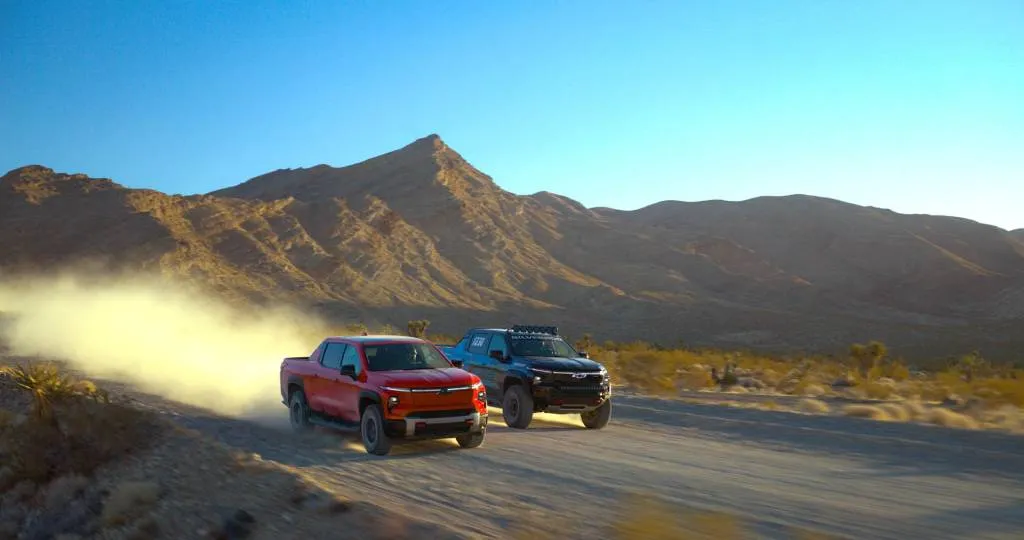
Chevrolet Silverado EV ZR2 race truck concept
In place of the production Silverado EV’s dual-motor all-wheel-drive powertrain, the concept features a tri-motor setup rated at 1,100 hp. It’s likely the same powertrain used in top versions of the GMC Hummer EV. The Silverado EV and Hummer EV are based on the same architecture, and GM has quoted similar output figures for the tri-motor Hummer powertrain.
Even with four-digit horsepower, the Silverado EV ZR2 is somewhat tamer than other electric off-road concepts we’ve seen recently. Audi fitted a set of portal axles to a concept version of its Q6 E-Tron crossover, while the Genesis GV60 Mountain Intervention Vehicle rides on tank-like tracks. But Chevy’s concept will actually compete in the Mint 400, a two-day, 400-mile desert endurance test.
Chevy isn’t discussing a production version of the Silverado EV ZR2 at the moment, but it will launch an off-road oriented Silverado EV Trail Boss grade for the 2026 model year. The Trail Boss will have a factory lift kit, 35-inch all-terrain tires on 18-inch wheels, and a Terrain Mode that provides increased maneuverability in tight spaces, according to Chevy. Such a truck will be right at home on the off-road trails of Moab, Utah, where Electrify America last year opened fast chargers that operate at the Silverado EV’s full 350-kw power rate.

VW ID.Every1 previews sub-$25,000 ID.1
Volkswagen on Wednesday unveiled a concept car previewing its smallest and cheapest EV yet.
The VW ID.Every1 is meant as a first glimpse at a sub-$25,000 electric car the automaker plans to launch in 2027—in Europe, at least. At 152.8 inches long, the four-door hatch is about the size of the outgoing Mini Cooper SE, and about 10 inches longer than the two-door Fiat 500e. The concept stands 58.7 inches tall and is 71.5 inches wide, creating a footprint that allows for seating for four and 10.8 cubic feet of cargo space, according to VW.
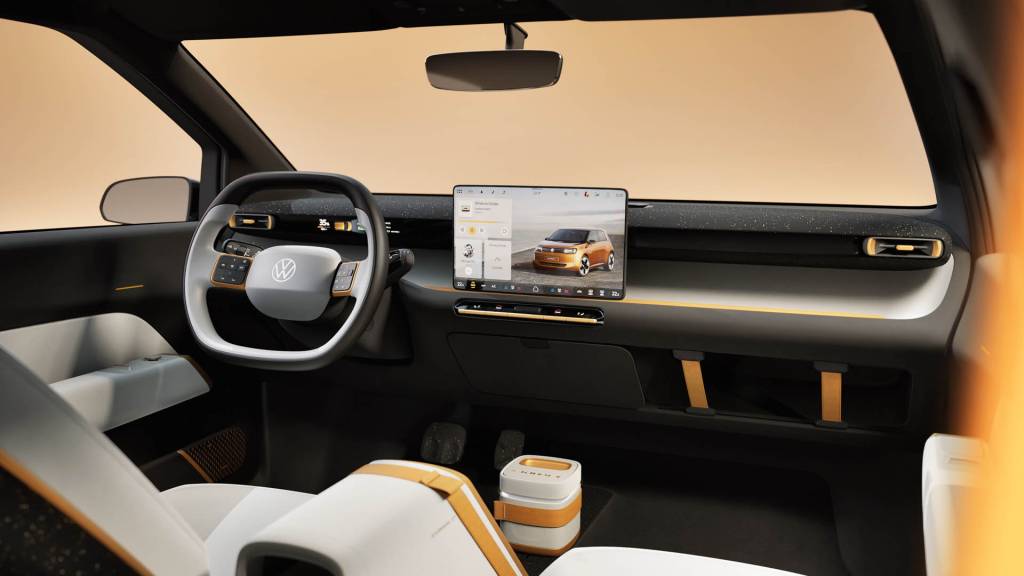
Volkswagen ID.Every1
In contrast to the retro look of the Mini and Fiat, the ID.Every1 has a contemporary design that emphasizes visual width, with wide fenders and an indent in the roof, as well as a cab-rearward profile normally associated with rear-wheel-drive vehicles that belies the concept’s mechanical layout.
The ID.Every1 is based on a front-wheel-drive platform that evolves VW’s MEB foundation for affordable EVs. Previous MEB models have been rear-wheel drive by default (with optional all-wheel drive), but VW said it chose front-wheel drive for reasons of space and efficiency. A 94-hp motor allows the concept to reach a top speed of 81 mph.
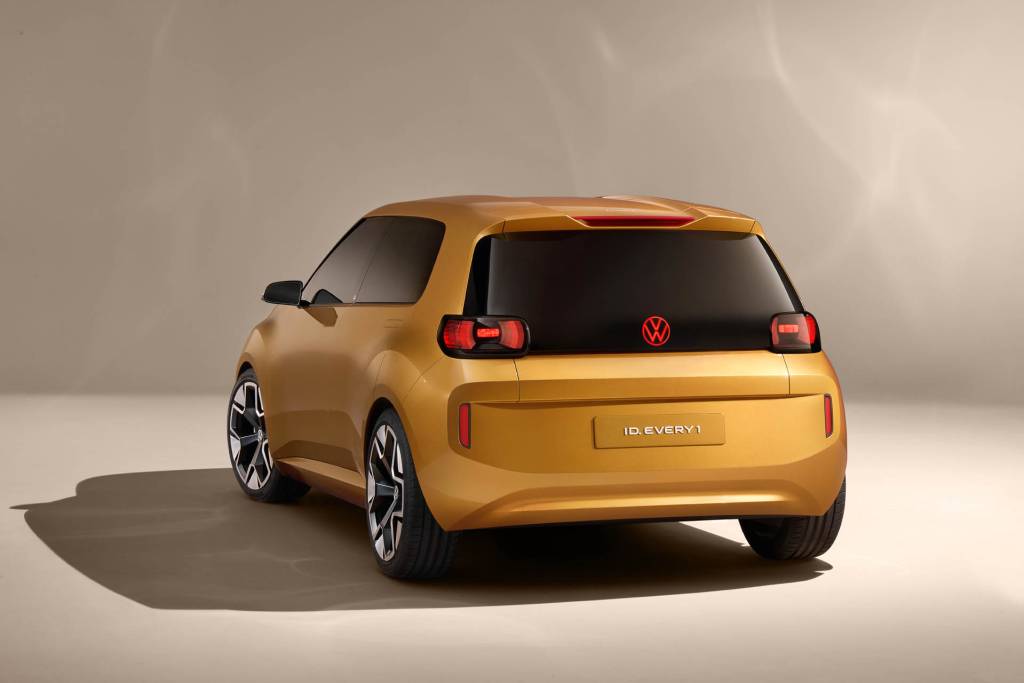
Volkswagen ID.Every1
Inside, the minimalist interior is meant as a home for gadgets. The passenger side of the dashboard has attachment points for the dashboard, and a removable Bluetooth speaker sits between the front seats, which are upholstered in material made from recycled PET plastic bottles. The ID.Every1 also borrows the sliding center console from the ID.Buzz electric van, which can be moved between the first and second rows.
The production version of the ID.Every1, likely to be called ID.1, targets a 20,000-euro base price (about $21,000 at current exchange rates). It’s one of nine new models VW plans by 2027, along with the ID.2all scheduled for a 2026 introduction and a starting price of around 25,000 euros ($26,000), and using the same front-wheel-drive MEB architecture.

Volvo ES90 debuts as a high-riding electric hatch
- Claimed to be most aerodynamic Volvo production car ever
- Single- or dual-motor versions, with 88 or 102 kwh of usable capacity
- 800-volt system good for 350-kw fast-charging, 10-80% in 20 min.
Volvo’s electric future won’t be limited to SUVs.
Unveiled early Wednesday morning, the Volvo ES90 houses the automaker’s latest tech in a traditional three-box shape. That shape says sedan, but the ES90 also has a raised ride height and a rear hatch instead of a trunk, similar to the smaller Polestar 2 from Volvo’s spinoff brand. The wheel-well gap left by that elevated ride height is filled by 20-inch or 22-inch wheels.
That shape pays dividends in drag reduction. Volvo quotes a drag coefficient of 0.25, compared to 0.29 for the EX90 three-row SUV with which the ES90 shares Volvo’s SPA2 architecture. It also makes the ES90 the most aerodynamic Volvo production car to date, according to the automaker.
At 196.9 inches long, the ES90 is just about the same length as a Lucid Air, but its 122.1-inch wheelbase is 5.6 inches longer. The Volvo is also three inches wider, and stands 5.4 inches taller in the lowest ride-height configuration, with the optional air suspension (steel coil springs are standard).
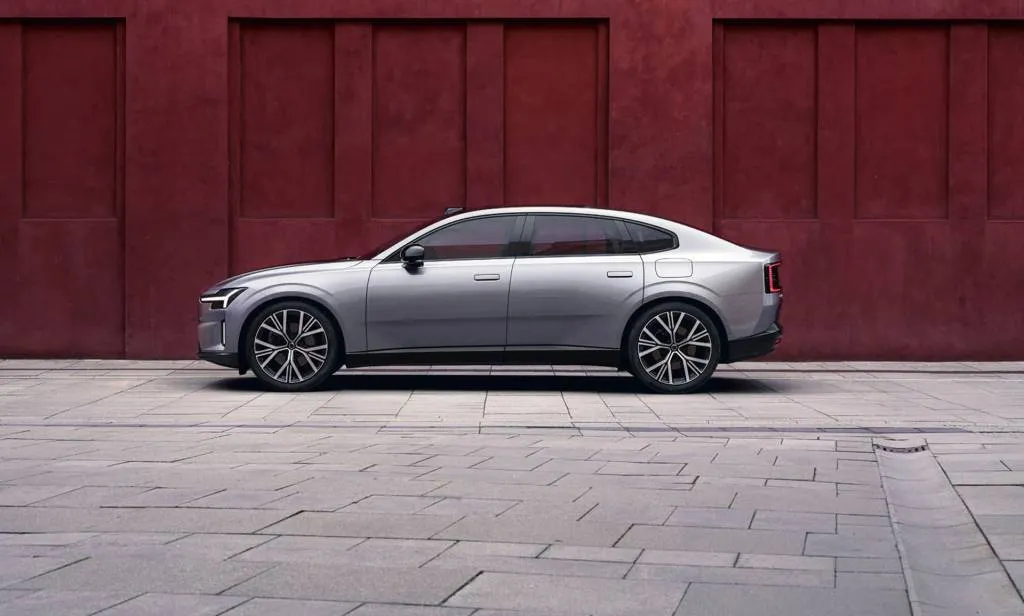
Volvo ES90
Offerings for the U.S. may differ, but in launch markets Volvo will offer a single-motor rear-wheel-drive version rated at 329 hp and 354 lb-ft of torque and capable of 0-60 mph in 6.7 seconds. Twin Motor models produce 442 hp and 495 lb-ft, getting them from 0-60 mph in 5.3 seconds. A Twin Motor Performance option ups output to 670 hp and 635 lb-ft, slashing the 0-60 mph time to 3.9 seconds.
Single-motor models have an 88-kwh (usable, 92-kwh gross) battery pack, while Twin Motor models have 102 kwh of usable battery capacity (106 kwh gross), both with “battery passport” software that tracks the origins of their raw materials. EPA range figures were not available at press time, but Volvo previously said it’s aiming for 435 miles on the European WLTP testing cycle with the larger pack.
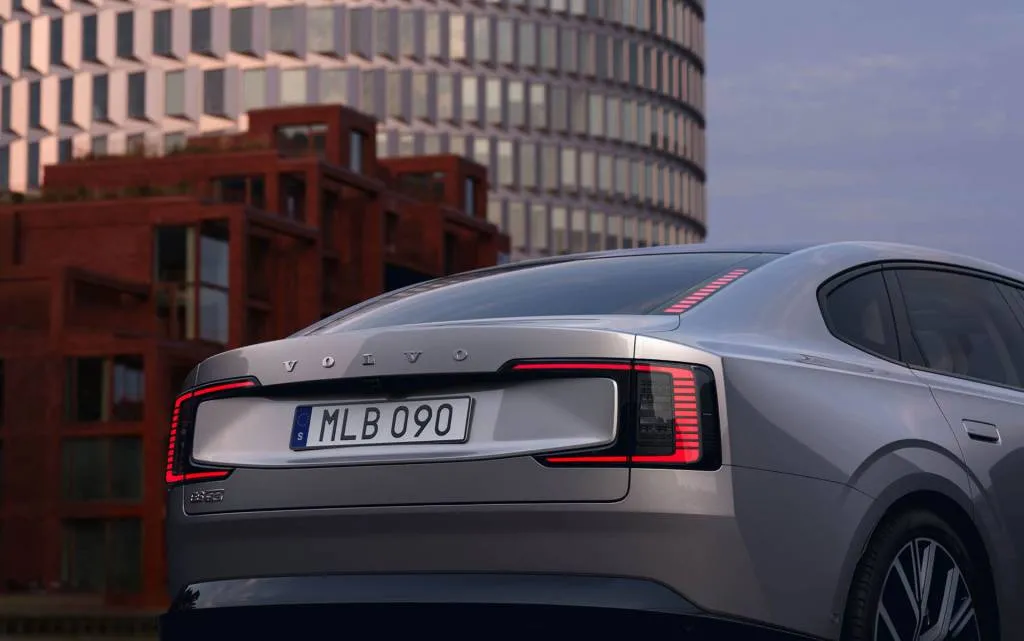
Volvo ES90
The ES90 advances from its EX90 platform mate with an 800-volt electrical architecture that will allow European-spec versions to charge at up to 350 kw, adding 186 miles of range in 10 minutes or completing a 10-80% charge in 20 minutes. A full recharge should take 10 hours for models with the larger pack and eight hours for the smaller-pack single-motor version.
Volvo promises to offer Plug and Charge capability in at least some markets, letting owners start charging at public stations simply by plugging in. And like the EX90, Volvo claims the ES90 is “hardware ready” for bidirectional charging.
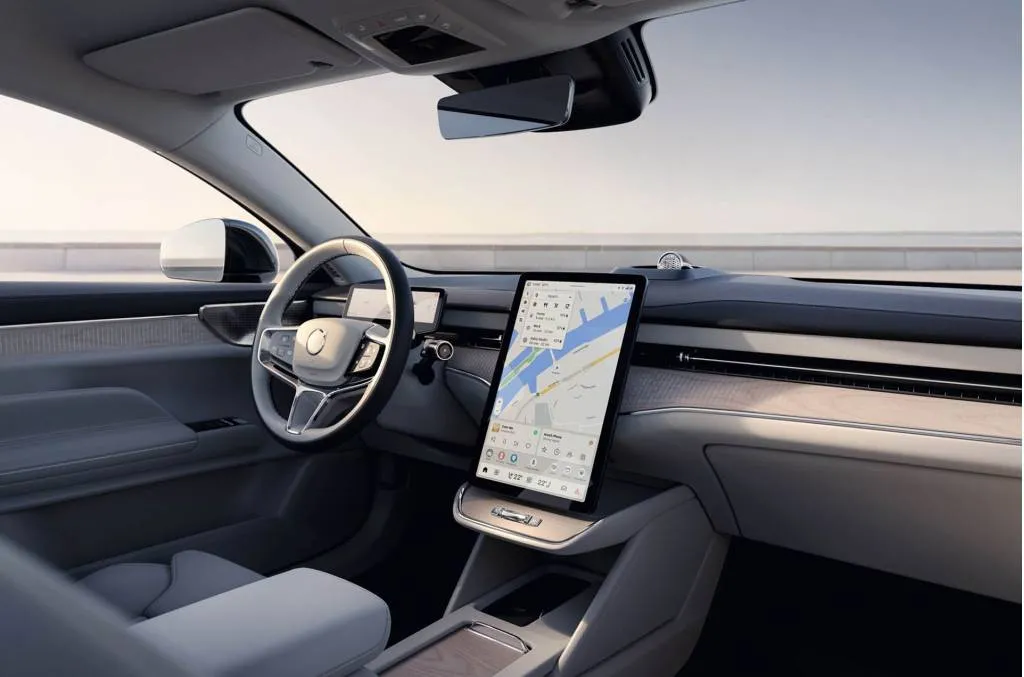
Volvo ES90
A 9.0-inch digital instrument cluster and 14.5-inch touchscreen are backed by Google apps, as in current Volvo models, while retaining wireless Apple CarPlay and Android Auto. Digital key functionality and a 25-speaker Bowers & Wilkins audio system will be available, while a more powerful computing stack based around Nvidia Drive AGX Orin chips, which is also due to be retrofitted to EX90 SUVs, will enable higher-level driver-assist features, Volvo claims.
The interior itself can be upholstered in Volvo’s Nordico material made from recycled PET plastic bottles, while all wood trim is certified sustainable by the Forest Stewardship Council (FSC), the automaker claims. Volvo also claims 29% recycled aluminum, 18% recycled steel, and 16% recycled polymers and bio-based materials.
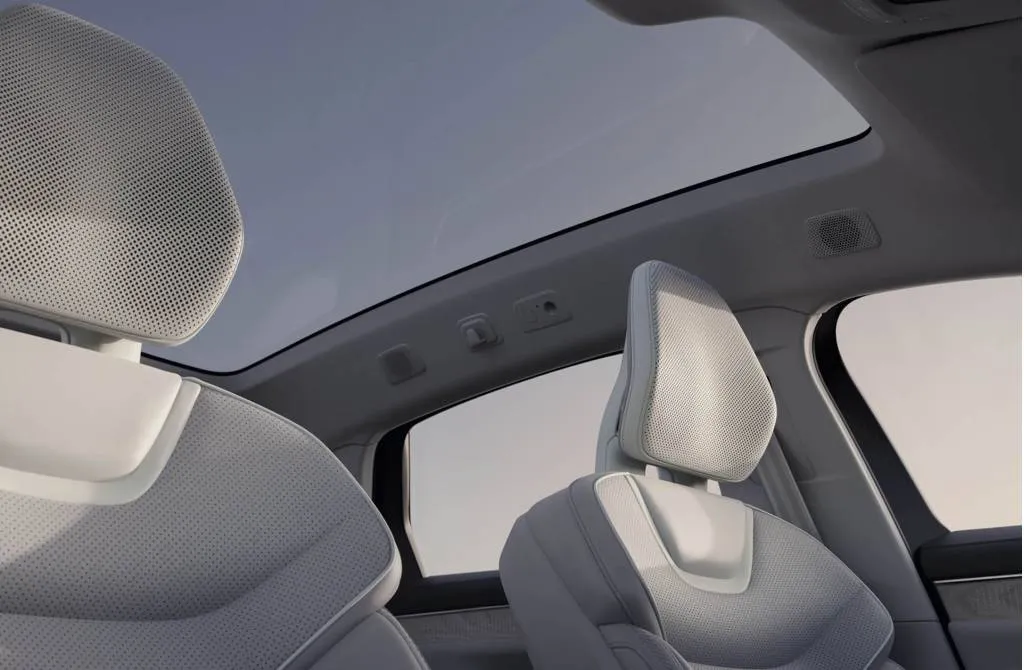
Volvo ES90
The ES90 is one of 10 new or updated models Volvo plans to introduce over the next two years, including a mix of EVs and plug-in hybrids. With the discontinuation of the S60 leaving the S90 as the only sedan in Volvo’s U.S. lineup, the ES90 is especially notable for bucking the SUV trend.

2026 Cadillac Escalade IQL costs $132,695, arrives mid-2025
Cadillac on Wednesday announced a stretched version of its Escalade IQ electric SUV.
Due to start production later this year, the 2026 Cadillac Escalade IQL boasts more interior space than the standard Escalade IQ, serving the same function Escalade ESV does in the internal-combustion Escalade lineup.
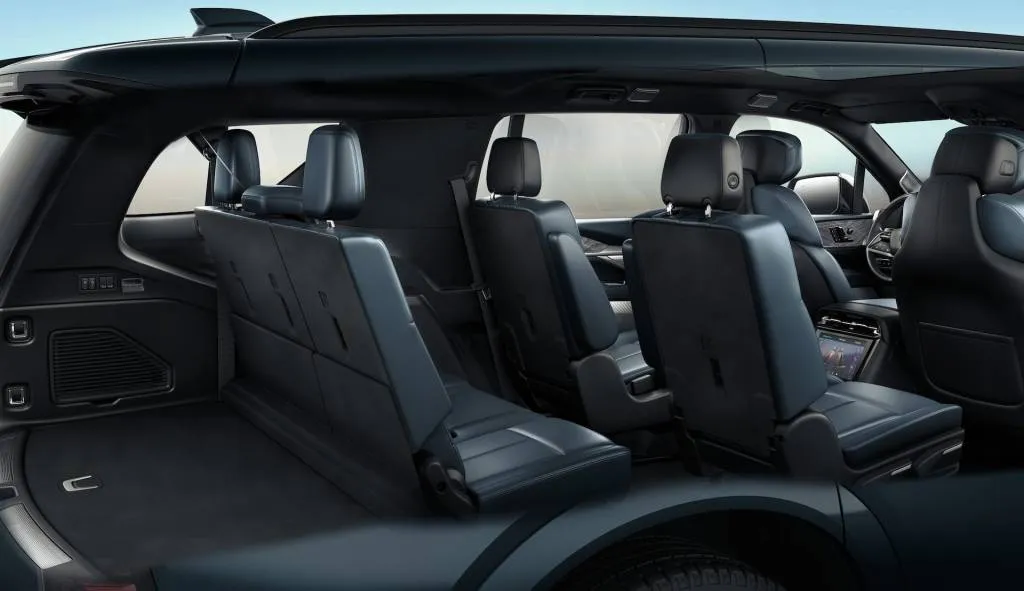
2026 Cadillac Escalade IQL
Cadillac points to an extra four inches of third-row legroom and an extra inch of headroom, at 36.7 inches and 38.2 inches, respectively. The IQL retains the Escalade IQ’s 12.2-cubic-foot front trunk, and the optional Executive Second Row Package, with dual 12.6-inch monitors, a center console, and 14-way power-adjustable seats with heating, cooling, and massage.
Like the Escalade IQ, the IQL rides on the same platform as the GMC Hummer EV, GMC Sierra EV, and Chevrolet Silverado EV trucks, and comes standard with the largest-available 205-kwh battery pack comprised of 24 modules in dual stacked layers.
Cadillac estimates the same 460 miles of range as the standard-length Escalade IQ. DC fast charging can recover 116 miles of range in 10 minutes at 350 kw, and bidirectional charging will be standard as well.
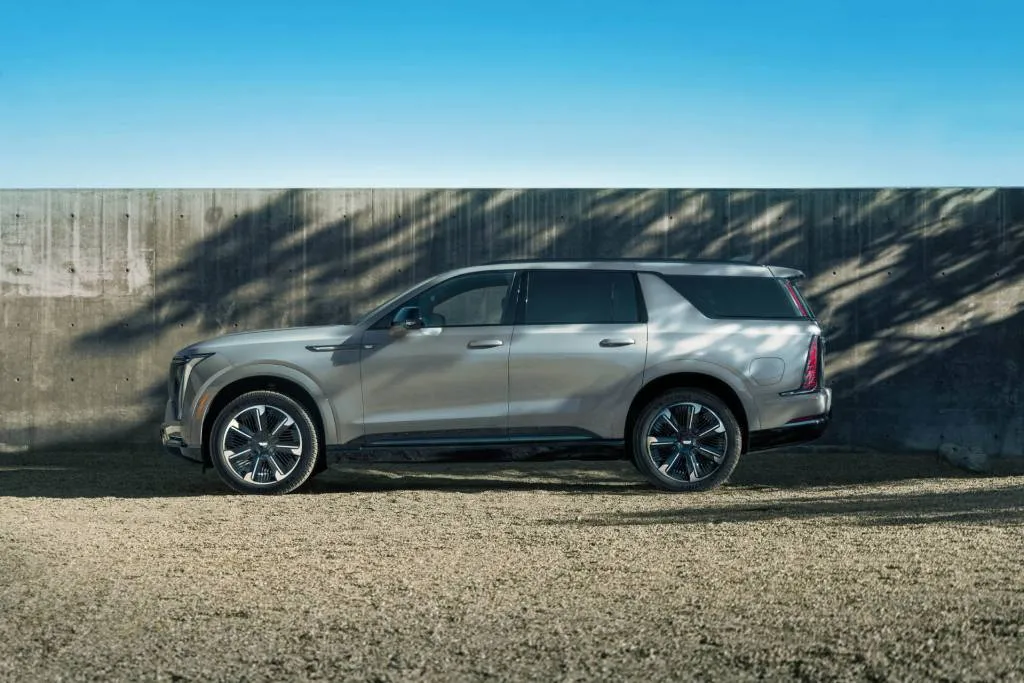
2026 Cadillac Escalade IQL
The IQL’s standard dual-motor powertrain is rated at the same 750 hp and 785 lb-ft of torque as in the Escalade IQ. Cadillac estimates that this will get the IQL from 0-60 mph in 4.7 seconds (using the Velocity Max launch mode) and enable a 7,500-pound towing capacity.
The IQL features magnetic dampers and adaptive air suspension like the IQ, as well as a 55-inch dashboard display running from roof pillar to roof pillar, AKG audio systems with up to 42 speakers, and General Motors’ Super Cruise hands-free highway driving system.
Prices start at $132,695 with destination. Cadillac hadn’t released pricing for the 2026 Escalade IQ at press time, but if it holds steady from the 2025 model year, the IQL will be $2,705 costlier. Cadillac will offer four trim levels for this model—Luxury, Sport, Premium Luxury, and Premium Sport.
Production is scheduled to start mid-year at GM’s Factory Zero in Detroit. The Escalade IQL won’t be the only three-row Cadillac electric SUV arriving for 2026. The Vistiq will offer three rows of seats and a targeted 300 miles of range in a more manageable size and with a lower $78,790 base price.

Electric Mercedes-Benz GLC prototype teased testing in the arctic
Mercedes-Benz is testing prototype electric versions of its GLC-Class crossover in the Arctic, the automaker confirmed Monday in a press release.
About two weeks ago, Mercedes announced the electric GLC, along with electric versions of the C-Class and E-Class sedans, would arrive by 2027. They’ll be among “dozens” of new or refreshed models the automaker plans to launch by that year.
With this release, Mercedes is now offering a first look at the electric GLC (under camouflage, that is) and confirming that it will be known as the GLC with EQ Technology. That’s the naming scheme that Mercedes has used for electric variants of combustion models since launching its electric G-Class off-roader.
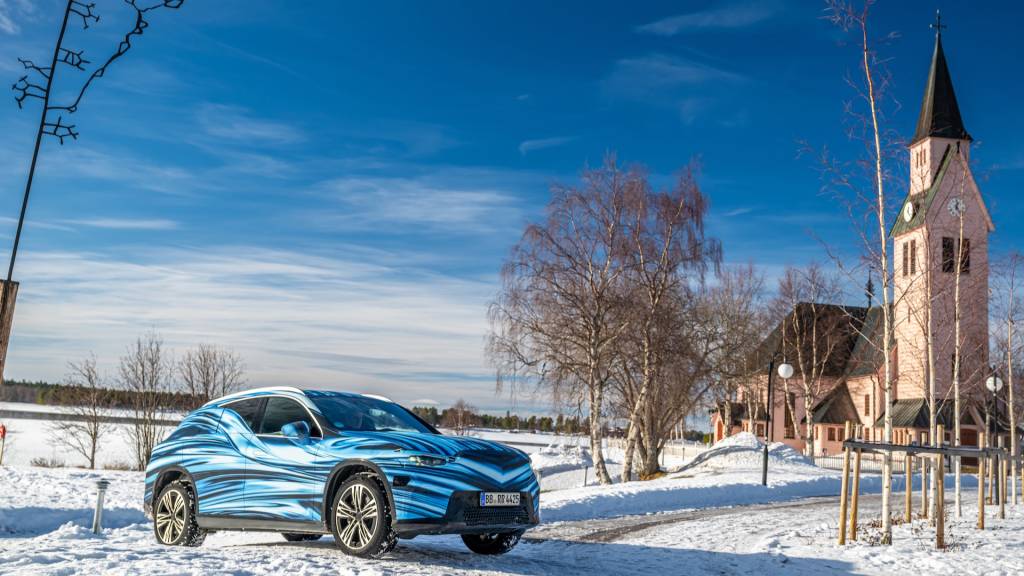
Mercedes-Benz GLC with EQ Technology prototype
A high-end version of the electric GLC will feature battery cells with anodes comprised of silicon oxide and graphite, Mercedes confirmed. Similar to chemistry previously discussed for the electric G-Class, it’s expected to boost energy density and keep the battery pack at a manageable size.
The GLC EV will also incorporate 800-volt charging, with a peak DC fast-charging rate of 320 kw, and a rear drive unit with a 2-speed transmission. These features will debut on the 2026 Mercedes-Benz CLA EV, although it’s unclear if the larger GLC will use that car’s Mercedes Modular Architecture (MMA) platform.
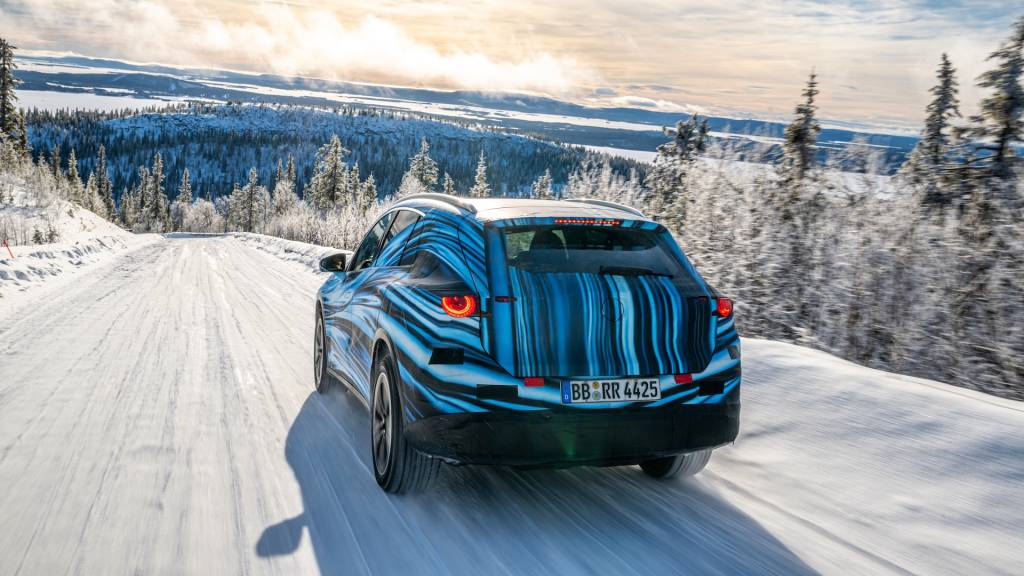
Mercedes-Benz GLC with EQ Technology prototype
A dual-motor all-wheel-drive system will be offered, utilizing the front-motor disconnect feature that debuted on the EQE SUV to boost efficiency when the extra traction isn’t needed. And perhaps in response to the criticism of brake feel in the earlier EQ models, Mercedes said the GLC EV will feature a braking system that combines the booster, master cylinder, and stability control unit into one module for “confident brake pedal feel that delivers precise and consistent feedback.”
Mercedes hasn’t confirmed the electric GLC for the U.S., but it would fill the same spot in the automaker’s lineup as the 2020 Mercedes EQC—which itself was all set to appear in this market but never made it.

Rivian adding range and power to R1T and R1S EVs via paid software upgrade
Rivian will soon push paid software upgrades that unlock more range and power in dual-motor versions of its R1S electric SUV and R1T electric pickup.
A Dual Performance upgrade will be available as part of Rivian’s 2025.06 software release, Wassym Bensaid, the automaker’s chief software officer, said in a post on X (formerly Twitter). The $5,000 upgrade will increase output in base dual-motor models from 533 hp and 610 lb-ft of torque to 665 hp and 829 lb-ft, dropping the estimated 0-60 mph time from 4.5 seconds to 3.4 seconds.
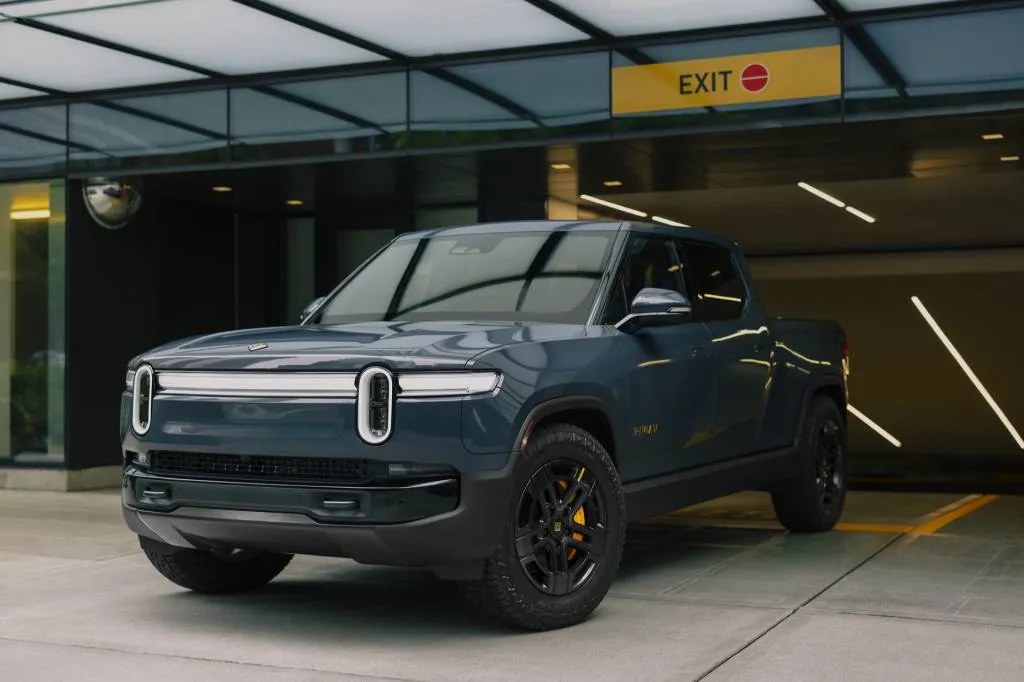
2025 Rivian R1T
That performance setup was part of the plan since the launch of the updated 2025 R1S and R1T, which are also still available with tri-motor and quad-motor powertrains. Tri-motor models produce 850 hp and 1,103 lb-ft and get from 0-60 mph in 2.9 seconds, while quad-motor models are rated at 1,025 hp and 1,198 lb-ft, enough to shave 0.4 second off the twi-motor’s 0-60 mph time.
The upgrade will be available on vehicles with the Standard+, Large, Large+, and Max battery packs, Bensaid said in the replies to the post, explaining that the base Standard Pack won’t get the upgrade because it “can’t reach same levels of performance.” The Standard Pack switched to LFP cells as part of the 2025-model-year overhaul of the R1T and R1S, and LFP chemistry is generally less flexible in its power-delivery characteristics.
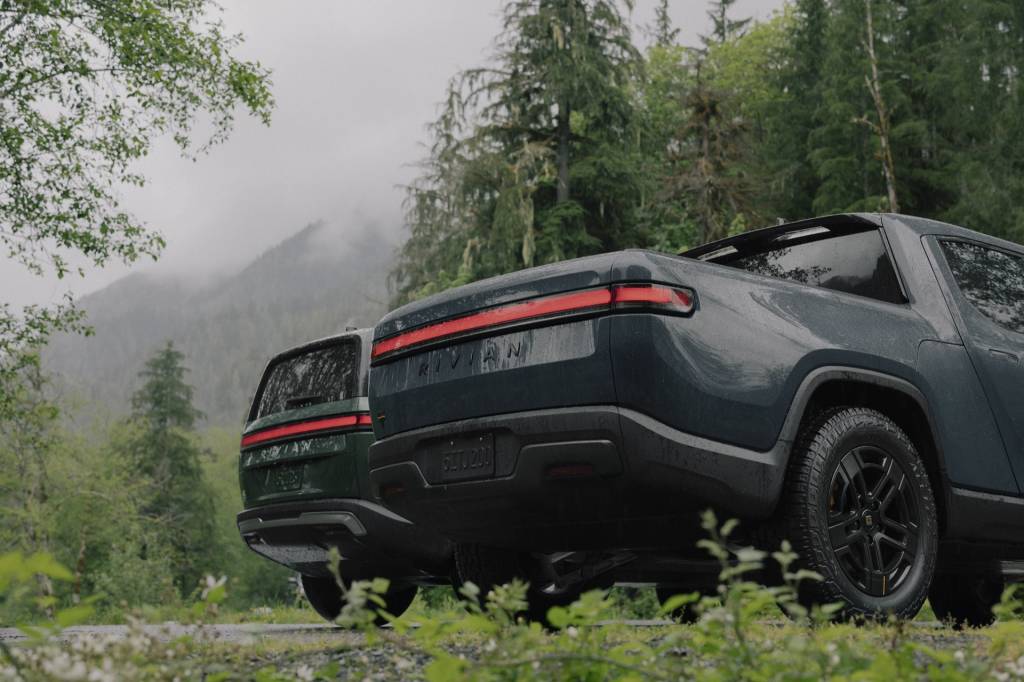
2025 Rivian R1T
A software update unlocking the full capacity of the Large+ Pack is “next on the roadmap,” Bensaid said in another reply. The Large+ is a 141.5-kwh Max Pack that with usable capacity that’s software-limited to match the 109.4 kwh of the Large Pack. Rivian began offering this option last year in an effort to meet demand for the Large Pack and get vehicles to customers sooner.
Rivian has been serious about pushing regular software updates. In December, it gave the infotainment system the ability to recognize owners’ wheel and tire swaps, while promising native text messaging, as well as launch control for pre-2025 Rivian models.

Massachusetts bidirectional EV charging program seeks to study use
Massachusetts will give residents free bidirectional electric vehicle chargers if they participate in a statewide bidirectional charging demonstration program.
Run by the Massachusetts Clean Energy Center (CEC), the program aims to place bidirectional chargers at residences and with fleet operators to show the possibilities of using EVs to supplement the grid or provide backup power for homes and buildings.
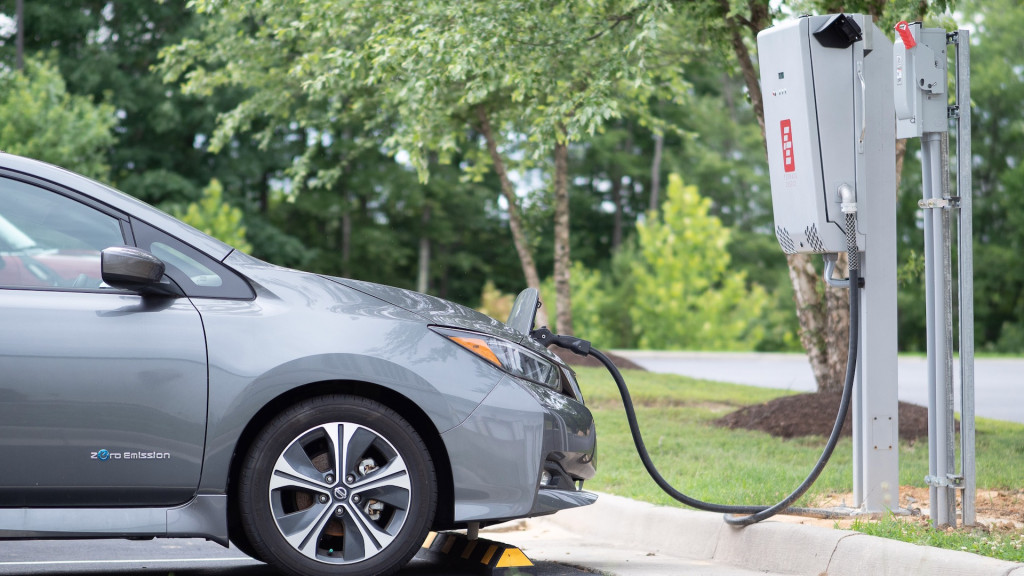
Nissan Leaf and Fermata Energy FE-15 bidirectional charger – Photo by Fermata Energy
Participants with EVs capable of bidirectional charging will receive free charging equipment, with installation costs also covered, in exchange for sharing data on charger use and maintenance, as well as potentially providing feedback on the experience of using bidirectional chargers, according to an FAQ document for the program. EV owners will get to keep the chargers after the program is finished.
By the numbers of chargers, it’s a relatively small program. The CEC plans to allocate 50-60 chargers for single-family homes, with an emphasis on environmental justice communities, and additional 30-40 chargers for commercial fleets across three to five sites, and 10-20 chargers for electric school buses across three sites.
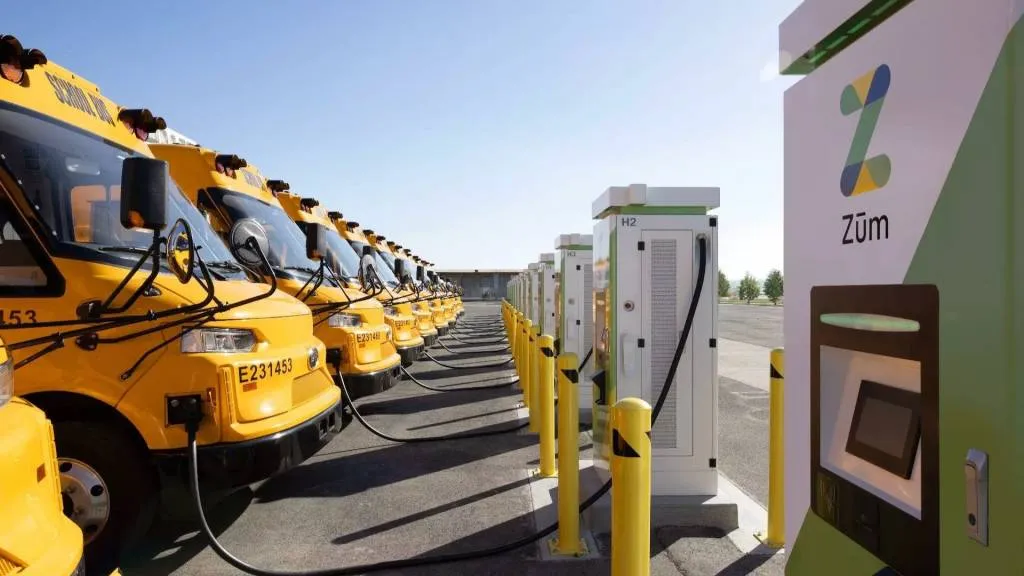
Electric school buses with Zum bidirectional charging stations
Applications for the program open in April, with onsite assessments in July through December. The CEC did not list a definitive date for the start of charger installations, but said it’s aiming to complete them by September 2026, with data reporting for the project wrapping up that December.
Numerous pilot programs and demonstrations have been conducted over the years around the ability of EVs to discharge power from their battery packs for other uses, but they’ve become more relevant as automakers like General Motors and Hyundai/Kia have begun building more vehicles with this capability. California has even floated a requirement for bidirectional charging capability in future EVs sold within its borders.

Solid-state batteries aren’t likely for Hyundai or Kia before 2030
Hyundai and Kia likely won’t have solid-state batteries ready for electric vehicles before the end of the decade, an executive said in an interview with Automotive News published Thursday.
“I don’t think we can commercialize these batteries before 2030,” Spencer Cho, head of global product planning for Kia, said Feb. 24 at the automaker’s EV Day presentation in Tarragona, Spain.
The three brands under the Hyundai Motor Group umbrella, including Hyundai, Kia, and Genesis, are pooling efforts to develop solid-state batteries in-house, Cho said. But whether that will lead to commercially-viable tech is unclear.
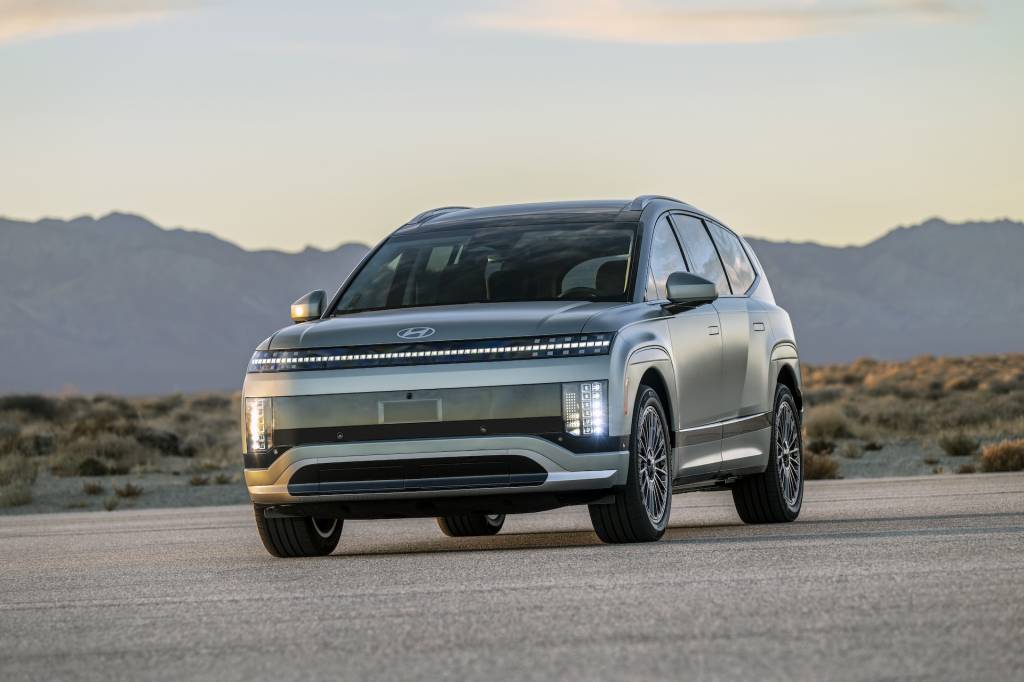
2026 Hyundai Ioniq 9
“Once our engineers believe that we have credible technologies that we can bring, then we might produce them on our own, Cho said, adding that “there is a lot of uncertainty about the progress of solid-state batteries.”
Hyundai has been proactive in developing its own LFP batteries that it can scale up for affordable EVs, independent of Chinese suppliers CATL and BYD, which today dominate the chemistry originally developed in the U.S. But the more conservative approach to solid-state batteries could leave the door open for a supplier stepping up ahead of Hyundai’s own in-house effort. Korean supplier SK On, for instance, sounds more optimistic and it recently claimed solid-state battery “breakthroughs”—in two different variants that could be put into running prototypes by 2027 and 2029.
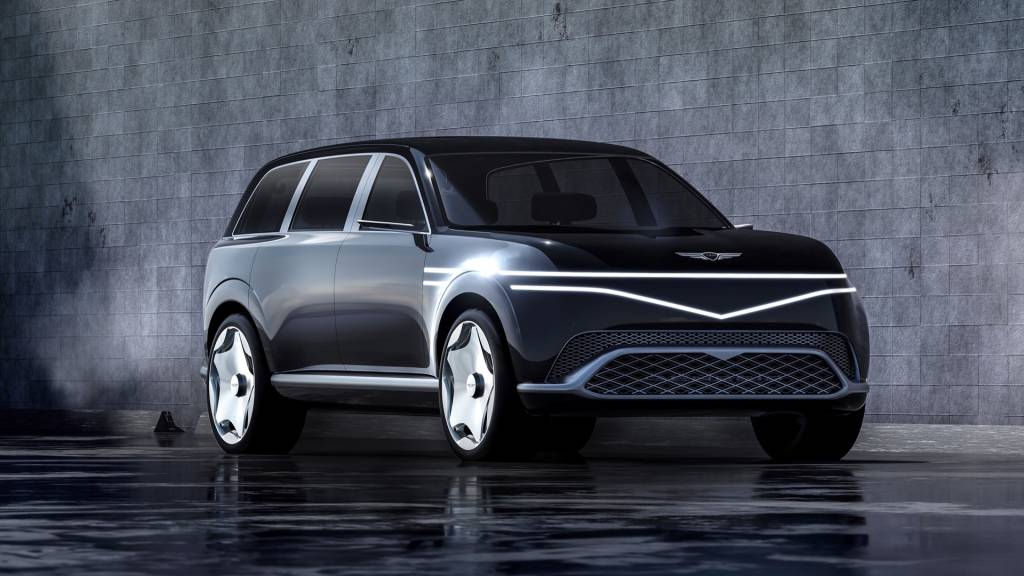
Genesis Neolun Concept – 2024 New York Auto Show
There’s a handful of automaker-supported firms and startups working to develop the solid-state batteries, too. But among automakers themselves working on the tech, the major Japanese automakers appear more confident in it than Hyundai Motor Group.
Nissan has pushed along with its own internal solid-state battery program and is hoping that they’ll help revolutionize and simplify the EV—with smaller battery packs and less or no cooling needs. Honda, too, has its own solid-state program and sees them arriving before the end of the decade—and as potentially enabling affordable EVs by 2030. Toyota also still plans to ramp up solid-state batteries for production models later this decade.

2025 Honda Prologue now tops 300 miles of range
The 2025 Honda Prologue electric SUV receives range and power boosts for its second model year, but remains priced just under $50,000.
All versions still have an 85-kwh battery pack, but Honda claims a 12-mile increase for the longest-range single-motor front-wheel-drive models, to 308 miles on the EPA cycle. Honda also expects EPA ratings for dual-motor all-wheel-drive models to increase by 13 miles, to 294 miles, for EX and Touring grades. The dual-motor Elite grade, with its 21-inch wheels and higher equipment level, is now estimated at 283 miles—10 more than previously.
A new front drive unit increases the output of single-motor models by 8 hp and 7 lb-ft of torque, to 220 hp and 243 lb-ft. All-wheel-drive models see increases of 12 hp and 25 lb-ft, to 300 hp and 355 lb-ft of torque.
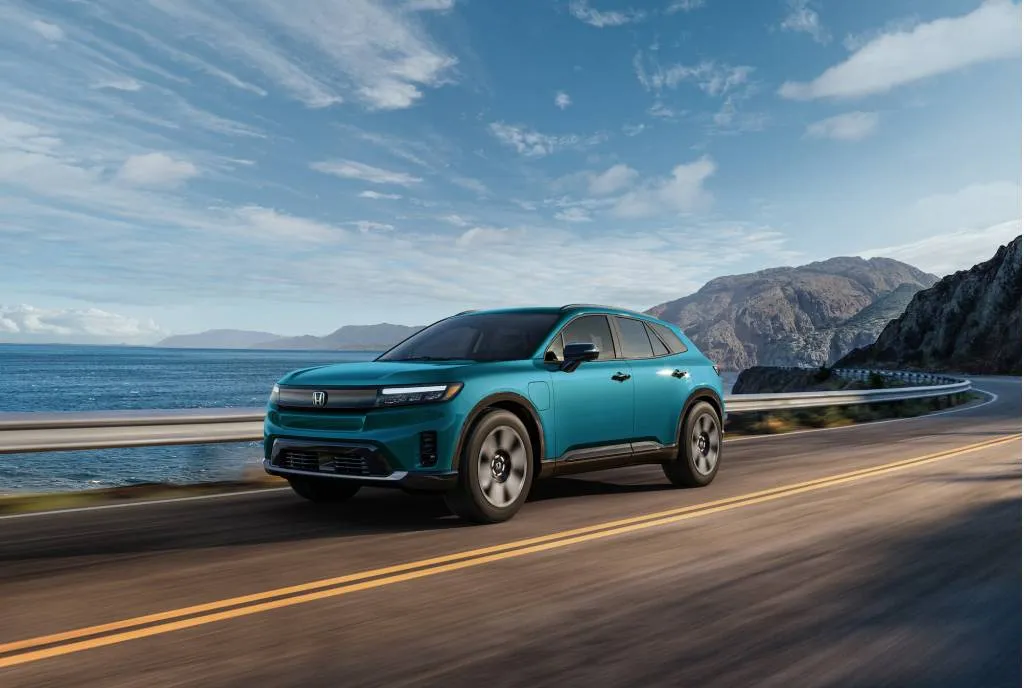
2025 Honda Prologue
The Prologue’s peak DC fast-charging rate of 150 kw is unchanged, allowing to gain 65 miles in 10 minutes of charging or get from 20-80% in 35 minutes. An 11.5-kw onboard charger allows for an eight-hour full charge for at least some of the lineup, given a 48-amp wallbox on a 60-amp circuit.
Honda expects all 2025 Prologue models to remain eligible for the full $7,500 federal EV tax credit—assuming it doesn’t go away. Even without the tax credit, the base single-motor Prologue EX’s starting price of $48,850 (including a $1,450 destination charge) is just $55 higher than the 2024 model year when it was new. Touring and Elite grades start at $53,150 and $59,350, respectively. All-wheel drive is a $3,000 option on the EX and Touring, but standard on the Elite.
The Prologue is based on a General Motors platform, but in a first drive of the 2024 model we found it to be a good on-ramp for current Honda owners looking to embrace EVs. That should make it a good warm-up for Honda’s in-house 0 Series EVs, the first of which are due to arrive in 2026.
